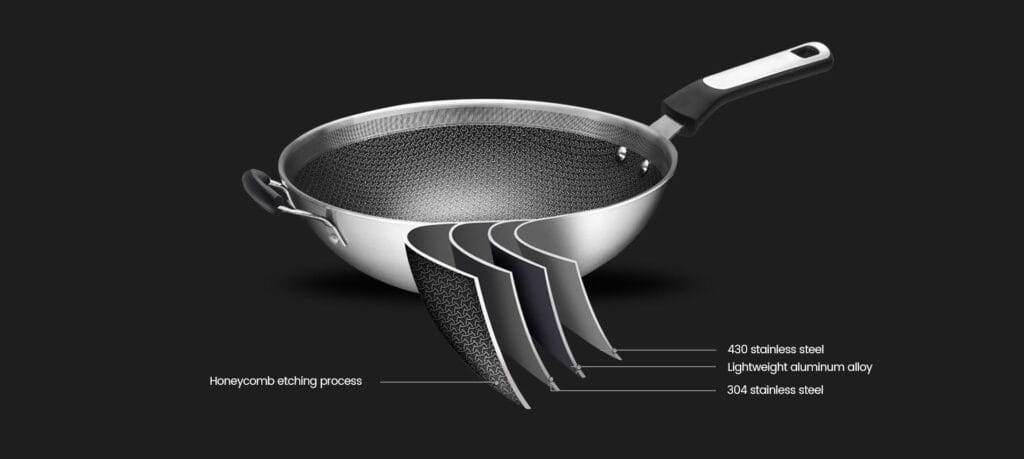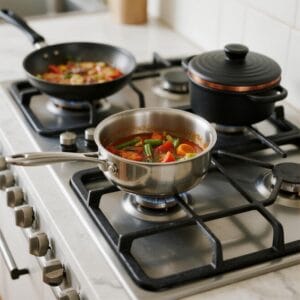Introduction:Triply clad steel and copper offer unique benefits in cooking
I’ve explored the differences between triply clad steel and copper cookware and found that each material offers distinct advantages in cooking performance. Triply clad steel is known for durability and even heating, while copper excels in quick heat response, making each material suited to different cooking styles.
Triply clad steel provides even, steady heating, making it ideal for slow-cooking and simmering, while copper offers rapid heat conductivity and precise temperature control. Copper’s high thermal conductivity allows for quick temperature adjustments, ideal for delicate dishes. Triply clad steel, on the other hand, holds heat longer and distributes it evenly across the pan, reducing hot spots and making it more versatile for general cooking.
Comparing these two materials has shown me that each brings unique strengths to the kitchen. For those who prioritize precision and speed, copper may be ideal, while triply clad steel offers reliability and versatility in everyday cooking.
Overview of Triply Clad Steel and Copper Cookware
- Triply Clad Steel: Features three bonded layers—stainless steel, aluminum core, and stainless steel—offering a non-reactive cooking surface and efficient heat distribution.
- Copper Cookware: Known for its excellent heat conductivity, copper cookware often comes with a stainless steel or tin lining to ensure food safety.


What Is Triply Circle Material and How Is It Made?
Triply circle material is an advanced composite used in cookware manufacturing. It consists of three bonded layers, each with specific functions that contribute to the overall performance of the cookware:
- Inner Layer (Cooking Surface): Made of high-quality stainless steel, this layer provides a non-reactive cooking surface that ensures food safety. It prevents any reaction between the food and the metal, preserving the taste and nutritional value of the ingredients.
- Middle Layer (Core): The core is made of aluminum, which is known for its excellent thermal conductivity. This layer is responsible for even heat distribution throughout the cookware, eliminating hot spots and ensuring consistent cooking results. The aluminum core extends across the entire cookware, including the sides, to maintain uniform heat during cooking.
- Outer Layer (Exterior Surface): The exterior layer is also made of stainless steel, which provides durability and strength. This layer is designed to be compatible with all types of cooktops, including induction. It also protects the aluminum core and makes the cookware resistant to rust, corrosion, and warping.
The production process of triply circle material involves bonding the stainless steel and aluminum under high heat and pressure through a technique called roll bonding. This process creates a seamless, fused material that provides optimal cooking performance by combining the best properties of each metal.

What Are the Key Features of Triply Circle Material?
- Non-Reactive Surface: The inner stainless steel layer ensures that the cooking surface is non-reactive, which means it will not alter the flavor or safety of the food.
- Excellent Heat Distribution: The aluminum core provides even heat distribution, preventing hot spots and ensuring consistent cooking results.
- Durability: The outer stainless steel layer adds durability, making the cookware resistant to warping, rust, and staining.
- Compatibility: Triply circle material is compatible with all types of cooktops, including induction, gas, electric, and ceramic.
Where Can Triply Circle Material Be Used?
- Cookware: Primarily used in the production of high-quality pots, pans, and skillets due to its efficient heat distribution and non-reactive properties.
- Kitchen Appliances: Triply circle material is also used in the production of kitchen appliances like electric skillets and griddles.
- Heat Exchangers: Due to its excellent thermal conductivity, triply circle material is suitable for heat exchangers used in industrial applications.
- Food Service Equipment: The durability and heat resistance make it ideal for use in commercial food service equipment.
Heat Conductivity and Distribution
- Triply Clad Steel
- Heat Conductivity: Moderate heat conductivity due to the aluminum core.
- Heat Distribution: Even heat distribution, minimizing hot spots.
- Copper Cookware
- Heat Conductivity: Superior heat conductivity, quickly responding to temperature changes.
- Heat Distribution: Exceptional heat distribution for precise cooking control.
Reactivity and Food Safety
- Triply Clad Steel: Non-reactive stainless steel ensures that the cookware does not react with acidic foods, preserving food flavor and safety.
- Copper Cookware: Unlined copper is reactive with acidic foods. Most copper cookware comes lined with stainless steel or tin to make it non-reactive and safe for cooking.
Weight and Handling
- Triply Clad Steel: Heavier due to the multiple bonded layers, offering stability but may be more challenging to handle.
- Copper Cookware: Generally lighter and easier to maneuver, although the thicker gauge copper pans may still have some weight.
Temperature Control and Cooking Versatility
- Triply Clad Steel: Holds heat well, suitable for searing, browning, and retaining heat for longer periods. Works well for high-heat cooking.
- Copper Cookware: Extremely responsive to heat changes, offering superior temperature control. Ideal for delicate cooking that requires precision, such as sauces.
Maintenance and Durability
- Triply Clad Steel: Low maintenance, highly durable, and resistant to rust, warping, and staining.
- Copper Cookware: Requires regular polishing to maintain its appearance. The lining (tin or stainless steel) can degrade over time and may need to be re-lined.
Cooking Applications
- Triply Clad Steel: Best for high-heat cooking methods like searing, roasting, and browning, as well as everyday cooking.
- Copper Cookware: Ideal for temperature-sensitive tasks like simmering, sauce-making, and caramelizing, thanks to its fast heat responsiveness.
Cost Considerations
- Triply Clad Steel: Generally more affordable than high-quality copper cookware, offering good value for its durability and versatility.
- Copper Cookware: More expensive due to the material cost and craftsmanship involved. Often considered a luxury choice for serious cooks.
Comparison Summary
- Heat Conductivity: Copper offers better conductivity, while triply steel provides even but moderate heating.
- Reactivity: Triply steel is non-reactive, while copper needs a lining to be safe for cooking.
- Maintenance: Triply steel is low maintenance, whereas copper requires regular upkeep.
- Cooking Versatility: Copper is ideal for precision cooking, while triply steel is better for high-heat cooking.
Frequently Asked Questions (FAQs)
- What is triply circle material?
- Triply circle material is a type of advanced composite used in cookware manufacturing. It consists of three bonded layers: an inner stainless steel layer for non-reactive cooking, an aluminum core for even heat distribution, and an outer stainless steel layer for durability and compatibility with all cooktops.
- How is triply circle material made?
- Triply circle material is made by bonding stainless steel and aluminum using a process called roll bonding, which involves applying high heat and pressure to create a seamless and durable composite.
- How does triply circle cookware compare to copper in terms of heat distribution?
- Copper has superior heat conductivity, offering faster temperature changes, while triply circle provides more even and moderate heat distribution.
- Is triply circle material safe for cooking acidic foods?
- Yes, the stainless steel inner layer of triply circle cookware is non-reactive, making it safe for cooking acidic foods.
- Can triply circle cookware be used on induction cooktops?
- Yes, the stainless steel exterior of triply circle cookware makes it compatible with induction cooktops.
- How does the weight of triply circle cookware compare to copper cookware?
- Triply circle cookware is generally heavier than copper, providing more stability during cooking but potentially being harder to handle.
- What are the advantages of using triply circle cookware over non-stick cookware?
- Triply circle cookware is more durable, can handle higher temperatures, and is free from harmful chemicals that may be found in some non-stick coatings.
- Does triply circle material require special maintenance?
- No, triply circle material is low maintenance and resistant to rust and staining, unlike copper which requires frequent polishing.
- Is copper cookware better for precise cooking compared to triply circle?
- Yes, copper’s superior heat responsiveness makes it ideal for precision cooking, while triply circle is better for even heat and versatility.
- Can triply circle cookware handle high-heat cooking?
- Yes, triply circle cookware is suitable for high-heat cooking methods like searing and browning.
- Which material is more affordable, triply circle or copper?
- Triply circle cookware is generally more affordable compared to high-quality copper cookware, offering great value for its durability and versatility.
- How long does triply circle cookware last?
- With proper care, triply circle cookware can last for many years due to its durable construction and resistance to warping.
- Is triply circle cookware non-toxic?
- Yes, triply circle cookware is non-toxic, and the stainless steel surface ensures no harmful chemicals leach into food.
- How does triply circle compare to cast iron for heat retention?
- Cast iron retains heat better, making it ideal for slow cooking, while triply circle provides faster, more even heating.
- Can I use metal utensils with triply circle cookware?
- Yes, metal utensils can be used, but it’s recommended to use wood or silicone utensils to maintain the surface quality over time.
- Is triply circle cookware suitable for professional kitchens?
- Yes, due to its durability, versatility, and efficient heat distribution, triply circle cookware is suitable for both home and professional kitchens.
Choosing between triply clad steel and copper cookware depends on your cooking preferences and needs. Copper cookware excels in heat responsiveness and precise temperature control, making it ideal for delicate cooking tasks like sauces and caramelizing. However, it requires more maintenance and can be quite expensive. On the other hand, triply clad steel offers excellent heat distribution, durability, and versatility, making it suitable for high-heat cooking methods and everyday use. It is also more affordable and low maintenance compared to copper.
Ultimately, both materials have their unique advantages, and the right choice depends on whether you prioritize precision and quick heat adjustment or durability and ease of use. By understanding these differences, you can make an informed decision that best suits your cooking style and preferences.







One Response